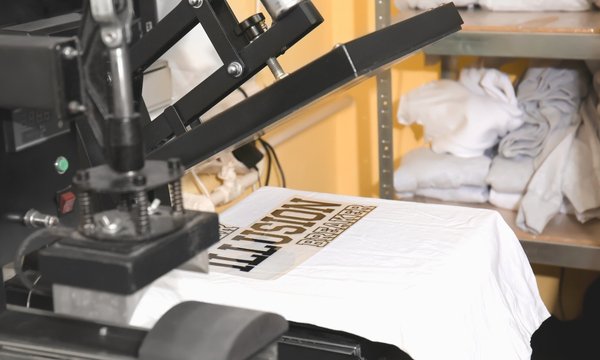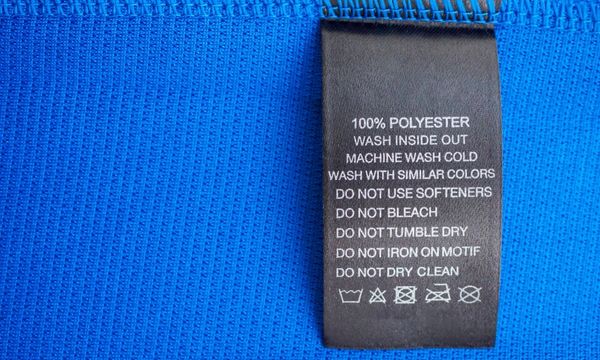We know from intuition that not all fabrics can handle intense heat and pressure. Some fabrics easily get burned when ironed. Some fabrics shrink or stretch when heated.
So, as someone who heat presses fabrics, it is understandable that you research whether a particular fabric is suitable for heat pressing before actually pressing it.
In this article, you will know whether polyester, a fabric notoriously known for being cheap and durable, can handle heat and pressure from a heat press.
This article also contains guides on how to properly adjust your heat press settings for polyester and poly blend fabrics.
Can you vinyl heat press on polyester?

So let us address the main question right away: Can you heat press vinyl on polyester?
Yes, you can heat press vinyl on polyester. However, you need to be very careful. Heat pressing polyester requires more skill than heat pressing cotton.
First of all, remember that not all polyesters are the same.
Polyester is known for being cheap and durable. It is blended with other types of fabric so that it can be used for various types of garments ranging from t-shirts to activewear.
Different types of polyester fabrics include acetate, rayon, acrylic, spandex, nylon, and other poly blends.
Now, not all of those polyester fabrics on the list are suitable for heat transfer vinyl printing. Polyester made from acrylic, for example, will melt at high temperatures.
A general rule that you can follow to ensure that your fabric can handle being under a heat press is to always look at the tag before pressing. The goal is to know what kinds of materials make up the polyester fabric you are using.
If it is a blend of polyester and some other material, then what percent does polyester take up on that fabric? Usually, fabrics that contain more than 65% polyester are suitable for heat transfer vinyl printing.
Also, the tag may contain phrases like “heat-sensitive polyester” or “do not iron”. In that case, you may need to adjust to a lower temperature to print on that fabric — that is, less than 270 degrees Fahrenheit.

If the label does not say anything like that, then the fabric is probably suitable for heat transfer vinyl printing at around 300 degrees Fahrenheit.
Second, do not pre-wash the fabric; make sure to pre-press before pressing the print. Pre-washing the shirt gives it extra moisture, and we do not want that. We want as little moisture as possible on the shirt.
But, if the product description instructs you to pre-wash it before pressing, then do so. Otherwise, it is better to leave the fabric dry.
Even if the fabric is dry and unwashed, pre-pressing polyester is still a step you must not skip. Pre-pressing not only evaporates moisture but also smoothens the area where you will place the heat vinyl transfer.
The print will stick easier and last longer on pre-pressed fabrics. Pre-pressing is usually done at 270 degrees Fahrenheit at medium pressure for around 10 seconds.
Third, use materials that are appropriate for polyesters. Choose heat transfer vinyls that have a strong adhesive, are durable, and can withstand thousands of wash and wear.
Usually, such HTVs are expensive. But believe us, they are much easier to work with than cheaper ones. Using more expensive options will save you time and energy and will boost your productivity in the long run.
Also, if you are working on a heat-sensitive fabric, you must use HTVs that work at lower temperatures.
Another necessary material for pressing polyester is a Teflon sheet. A thin Teflon sheet can significantly lessen the possibility of burning your polyester fabric. If you don’t have one, parchment paper is a good alternative.
Do not use thick Teflon sheets as they may affect the temperature of the heat press. Make sure that the sheet covers the whole area of the fabric under the heat press.
Finally, do not underestimate the power of the trial and error process. The guidelines above, although comprehensive, are not 100 percent foolproof.
There are instances in which the tags on some fabrics are inaccurate or incomplete. Also, some HTVs may not work well on some polyester fabrics.
That said, it is essential to try pressing a sample piece of fabric first before pressing a whole batch.
Try pressing vinyl on a small piece of fabric, then wash and rub it a few times in the same way you wash your laundry. See if the print adheres after washing.
You may also try just pressing the polyester fabric without the print. See if the polyester discolors or not.
In trying the limits of your fabric and print, we recommend that you start on lower temperatures yet longer press times. You can lengthen the duration of your press as you go higher in temperature. But remember, pressing longer in low temperatures is better and less risky.
For example, you can try pressing at 270 degrees Fahrenheit for 20 seconds instead of 305 degrees Fahrenheit for 10 seconds. See what combination of temperature and duration works best for your project.
Heat Press Polyester Temperature
So yes, we can heat press polyester. But what temperature do you set the heat press for polyester?
As mentioned, different polyester fabrics vary in the temperature they can handle without scorching.
Some polyesters cannot tolerate heat. Delicate, heat-sensitive polyesters can be pressed on 270 degrees Fahrenheit or lower.
Regular polyesters can be pressed at temperatures higher than 300 degrees Fahrenheit. For comparison, you can press 100% cotton at 380 degrees Fahrenheit.
Since polyester fabrics are varied, we cannot give you a specific temperature that would work on all polyester fabrics. The key is to consult your fabric’s laundry tag.
If you want to be extra careful, you may want to experiment with a small cut of fabric first. Simply press the sample fabric under a heat press with your preferred temperature.
Make sure to start with low temperatures first. Work your way upwards until you reach the temperature at which the fabric scorches.
By doing so, you will know the temperature limit of your fabric. This will help you lessen mistakes when you work on the whole batch.
Can you heat press 100 percent polyester?

Yes, you can heat press 100% polyester. But remember that 100% polyester is sensitive to heat. If you press on temperatures that are higher than it can tolerate, polyester may scorch or have permanent discoloration.
It is advisable to use Teflon sheets to lessen the possibility of scorching. The proper amount of time, pressure, and temperature are the keys to perfect heat pressing on polyester.
This leads us to our next question.
How long do I heat press 100% polyester?
How long to heat press polyester highly depends on the temperature of the heat press.
If the heat press is set at a relatively low temperature, you may increase the duration of the press. If your heat press is set at high temperatures, it follows that you should decrease the duration of the press.
On average, 100% polyester is heated at 270 degrees Fahrenheit for 10 seconds. You may increase or decrease both the temperature and the time if you think it is necessary.
Can you heat press polyester spandex?
Yes, you can heat press polyester spandex.
Spandex is a stretchy synthetic material. Since it is synthetic, it is highly likely to burn or gloss at high temperatures. But, as mentioned earlier, different fabrics are sensitive to heat at varying degrees.
In the case of polyester spandex, they fall under the heat-sensitive category, meaning they can be pressed at 270 degrees Fahrenheit for 10 seconds.
If you plan to print HTV on a polyester spandex fabric, consider using a stretchy HTV. Unlike regular HTV prints, this one stretches with the fabric even after cooling down.
There are various stretchy HTVs in the market; you just need to experiment with what brand you can work best with.
Can you heat press polyester cotton blend?
Yes, you can heat press polyester cotton blend.
For a 50% cotton and 50% polyester combination, you may press it at 340 degrees Fahrenheit for 10 seconds.
For other cotton to polyester ratios, we cannot be sure. This is where you can use the trial and error method. As a general guide, polyester is more heat-sensitive than cotton.
So, if a fabric has more polyester than cotton, you may want to ease up on the temperature. Start with the safest temp: 270 degrees Fahrenheit.
Cotton is far more heat-resistant than polyester. If the fabric has more cotton than polyester, you may start at mid temperatures — around 300 degrees Fahrenheit.
For reference, the maximum temperature that 100% cotton can handle is 340 degrees Fahrenheit.
Can you use the Cricut heat press on polyester?
Yes, you can use the Cricut heat press on polyester and polyblends. However, you have to adjust to the new rules of Cricut.
You may want to check the instructions from your Cricut’s manual. But to give you a general idea, I will show you how different a Cricut EasyPress is from a regular heat press.
Unlike a regular heat press that requires as little as 270 degrees Fahrenheit for 10 seconds to press polyester, a Cricut EasyPress 285 degrees Fahrenheit for 15 seconds does the same thing.
A regular heat press can successfully transfer print to fabric in around 10 seconds, while the Cricut EasyPress takes up to 50 seconds. Maybe this difference in time and temperature has something to do with pressure.
Heat presses can apply more pressure to the fabric, thus lessening the press time. The Cricut EasyPress, on the other hand, relies on how hard you press the device to the material.
When using a Cricut EasyPress, you must press the back side of the print for an additional 10-15 seconds.
From here, you may have realized already that using Cricut is slightly more time-consuming than using a regular heat press.
If you want a comprehensive temperature guide on using a Cricut EasyPress, check out this article.
If you want to see a video on how to properly use a Cricut EasyPress, watch this.
YES! to Polyester
With all the information above, we have proven that polyester is suitable to be under a heat press but at low temperatures.
You can now begin to explore the various designs you can print on this cheap yet durable fabric.
We hope this article serves as an effective guide for creatives like you. But remember, as a creative, it is part of your craft to try various methods of creating until you find the practice that suits you best.
This article is merely a guide. Who knows? In your journey to efficiency and perfection, you might find better ways of printing on polyester than what is written in this article.




Leave a Reply